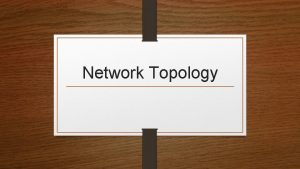Network topology Free Powerpoint Templates Page 1 Network















- Slides: 15

Network topology Free Powerpoint Templates Page 1

Network topology • • Network topology is the arrangement of the various elements (links, nodes, etc. ) of a computer network. It is the topological structure of a network, and may be depicted physically or logically. » Physical topology refers to the placement of the network's various components, including device location and cable installation, while logical topology shows how data flows within a network, regardless of its physical design. Free Powerpoint Templates Page 2

Type of topology • • Network topologies are categorized into the following basic types: – Bus – Ring – Star – Mesh – Tree More complex networks can be built as hybrids of two or more of the above basic topologies. Free Powerpoint Templates Page 3

Bus Topology • • Bus networks use a common backbone to connect all devices. A single cable, the backbone functions as a shared communication medium that devices attach or tap into with an interface connector. A device wanting to communicate with another device on the network sends a broadcast message onto the wire that all other devices see, but only the intended recipient actually accepts and processes the message. Ethernet bus topologies are relatively easy to install and don't require much cabling compared to the alternatives. 10 Base-2 ("Thin. Net") and 10 Base-5 ("Thick. Net") both were popular Ethernet cabling options many years ago for bus topologies Free Powerpoint Templates Page 4

Bus Topology • This diagram illustrates the bus network topology. A bus topology such as 10 Base-2 or 10 Base-5 Ethernet uses a single communication backbone for all devices. Free Powerpoint Templates Page 5

Ring Topology • • In a ring network, every device has exactly two neighbors for communication purposes. All messages travel through a ring in the same direction (either "clockwise" or "counterclockwise"). A failure in any cable or device breaks the loop and can take down the entire network. To implement a ring network, one typically uses FDDI, SONET, or Token Ring technology. Ring topologies are found in some office buildings or school campuses. Free Powerpoint Templates Page 6

Ring Network Topology • This diagram illustrates the ring network topology. A ring topology such as FDDI or SONET sends messages clockwise counter clockwise through the shared link. Free Powerpoint Templates Page 7

FDDI • • Fiber Distributed Data Interface (FDDI) is a standard for data transmission in a local area network. It uses optical fiber as its standard underlying physical medium, although it was also later specified to use copper cable, in which case it may be called CDDI (Copper Distributed Data Interface), standardized as TP-PMD (Twisted-Pair Physical Medium-Dependent), also referred to as TP-DDI (Twisted-Pair Distributed Data Interface). Free Powerpoint Templates Page 8

SONET • Synchronous Optical Networking (SONET) and Synchronous Digital Hierarchy (SDH) are standardized protocols that transfer multiple digital bit streams over optical fiber using lasers or highly coherent light from light-emitting diodes (LEDs). At low transmission rates data can also be transferred via an electrical interface. Free Powerpoint Templates Page 9

Star Topology • • • Many home networks use the star topology. A star network features a central connection point called a "hub node" that may be a network hub, switch or router. Devices typically connect to the hub with Unshielded Twisted Pair (UTP) Ethernet. Compared to the bus topology, a star network generally requires more cable, but a failure in any star network cable will only take down one computer's network access and not the entire LAN. (If the hub fails, however, the entire network also fails. ) Free Powerpoint Templates Page 10

Star Topology • • This diagram illustrates the star network topology. A star topology typically uses a network hub or switch and is common in home networks. Free Powerpoint Templates Page 11

Tree Topology • • • Tree topologies integrate multiple star topologies together onto a bus. In its simplest form, only hub devices connect directly to the tree bus, and each hub functions as the root of a tree of devices. This bus/star hybrid approach supports future expandability of the network much better than a bus (limited in the number of devices due to the broadcast traffic it generates) or a star (limited by the number of hub connection points) alone. Free Powerpoint Templates Page 12

Tree Network Topology • This diagram illustrates the tree network topology. A tree topology integrates the star and bus topologies in a hybrid approach to improve network scalability. Free Powerpoint Templates Page 13

Mesh Topology • Mesh topologies involve the concept of routes. Unlike each of the previous topologies, messages sent on a mesh network can take any of several possible paths from source to destination. (Recall that even in a ring, although two cable paths exist, messages can only travel in one direction. ) Some WANs, most notably the Internet, employ mesh routing. A mesh network in which every device connects to every other is called a full mesh. As shown in the illustration below, partial mesh networks also exist in which some devices connect only indirectly to others. Free Powerpoint Templates Page 14

Mesh Network Topology • This diagram illustrates the mesh network topology. A mesh topology provides redundant communication paths between some or all devices (partial or full mesh). Free Powerpoint Templates Page 15
 Free ppt templates allppt.com
Free ppt templates allppt.com Allppt templates
Allppt templates Ppt islamic free
Ppt islamic free Allppt.com _ free powerpoint
Allppt.com _ free powerpoint Sejenis kubur batu , tetapi memiliki tutup diatasnya
Sejenis kubur batu , tetapi memiliki tutup diatasnya Usu powerpoint template
Usu powerpoint template Free real estate powerpoint templates
Free real estate powerpoint templates Allppt template
Allppt template Free elearning templates for powerpoint
Free elearning templates for powerpoint Advantages of hydroelectricity
Advantages of hydroelectricity Freepowerpointtemplatesdesign
Freepowerpointtemplatesdesign Allppt free template
Allppt free template Network topology ppt download
Network topology ppt download What is topology in computer
What is topology in computer Marketo program tokens
Marketo program tokens Powerpoim
Powerpoim





























